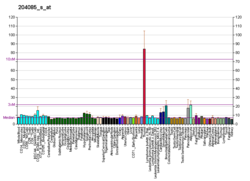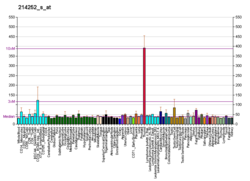Top Qs
Timeline
Chat
Perspective
CLN5
Protein-coding gene in humans From Wikipedia, the free encyclopedia
Remove ads
Ceroid-lipofuscinosis neuronal protein 5 is a protein that in humans is encoded by the CLN5 gene.[5][6][7]
The neuronal ceroid lipofuscinoses (CLN or NCL) are a group of autosomal recessive, progressive encephalopathies in children. They are characterized by psychomotor deterioration, visual failure, and the accumulation of autofluorescent lipopigment in neurons and other cell types. The main childhood forms are the infantile type (Santavuori-Haltia disease; MIM 256730), the late infantile type (Jansky–Bielschowsky disease; MIM 204500), and the juvenile type (Batten disease; MIM 204200) based on the age of onset, clinical course, neurologic and ophthalmologic findings, and ultrastructural analysis (Carpenter et al., 1977 [PubMed 193610]).[supplied by OMIM][7]
A human clinical trial of gene therapy for the CLN5 form of Batten disease began in 2022 through the University of Rochester, using vectors developed by the Hughes research lab in New Zealand.[8]
Remove ads
References
Further reading
External links
Wikiwand - on
Seamless Wikipedia browsing. On steroids.
Remove ads







